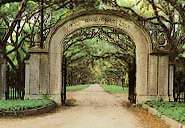Wormsloe Plantation
 Wormsloe Plantation, in ruins.
Noble Jones was born 1702 in London, the son of Edward and Januarye Jones. He was married in 1723 to Sarah Hook, and sailed with General Oglethorpe on November 6, 1732, arriving in Savannah on February 1, 1733. He was the first colonial surveyor in the colony, a physician and carpenter. He fought with General Oglethorpe in the Siege of Augustine against the Spanish and in August of 1740 was sent to watch the Narrows of Skiodoway Island. He was commissioned to the rank of lieutenant, later captain, by General Oglethorpe.
Wormsloe Plantation, in ruins.
Noble Jones was born 1702 in London, the son of Edward and Januarye Jones. He was married in 1723 to Sarah Hook, and sailed with General Oglethorpe on November 6, 1732, arriving in Savannah on February 1, 1733. He was the first colonial surveyor in the colony, a physician and carpenter. He fought with General Oglethorpe in the Siege of Augustine against the Spanish and in August of 1740 was sent to watch the Narrows of Skiodoway Island. He was commissioned to the rank of lieutenant, later captain, by General Oglethorpe.
Jones was also very active in the Crown's politics, and in 1740 established a very large plantation Wormsloe on Hope Island, near the mouth of the Vernon River. The plantation had large cypress and live-oak trees. All that is left today is the archway leading into the plantation, and ruins.
His son, Noble Wimberly Jones owned 1,800 acres of land fifteen miles from Rocky Comfort, in St. George's Parish (Burke County). As astute visitor to Wormsloe in 1743 alluded... "Wormsloe is one of the most agreeable spots I ever saw, and the improvements of that ingenious man are very extraordinary; He commands a company of Machines who are quartered in huts near his house, which is also a tolerable defensible place with small arms. From the house there is a vista of near three miles cut through the woods to Mr. Whitefield's Orphan House, which has a very fine effect on the sight." (London Magazine, 1745, page 552).
The tabby ruins of the above fortress still exist, set among live-oaks, palmettos, magnolis and cedars. In 1750, he petitioned for 500 acres on the Little Ogeechee River, combining to make 800 acres located on the northside of the river, where he used sixteen Negro slaves. In October of 1771 he petitioned the trustees for 500 additional acres, stating that he had some time ago purchased a plantation from Inego Jones on the Island of Skidoway and that he had reason to believe that there might be considerable quantity of surplus land within the line of said survey. In 1768 he was a Member of the Georgia Council as well as a Conservator of the Peace. He died November of 1775 and was buried in the Bonaventure Cemetery in Savannah.

